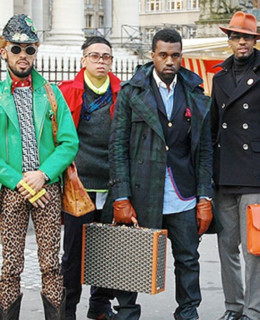Raise your hand if you grew up in the nineties and your mom made you and your siblings wear a Polo Ralph Lauren teddy bear sweater on at least one Christmas family pic occasion. Funny detail: while you were very busy “cheeeeeeeese”-ing alongside your fam, a couple of foul-mouthed guys were rapping about their bitches, money problems and murdered bro’s, all the while sporting the exact same sweater. Hu?
“But I’m doing pretty good as far as geniuses go, and I’m doing pretty hood in my pink polo.” These lines are taken from Barry Bonds, a 2007 single that put Kanye West on the map as a lyrical genius and respected hip hop artist. Polo Ralph Lauren is the show pony of American rap, so it seems. Research the term “polo” on Genius.com and you’ll find hundreds of resulting lyrics. Google Drake, Lil Wayne, Chance The Rapper and Chris Brown coupled with the famous brand, and your screen will explode with rappers clad in colorful preppy clothes and proudly wearing their teddy bear.
It’s a funny sight, but the reason behind it is dead serious: the trend goes back to life on the streets and the Lo Life gang in particular, a crew of teenage shoplifters that prowled the streets of Brooklyn in the late eighties and dressed head-to-toe in Polo Ralph Lauren. The so-called Lo Lifes were popular in the underground clubs of New York’s ghettos, where they mixed with established rappers and some of them, such as the crew’s co-founder Thirstin Howl III, even managed to build their own careers in the genre. This way the movement evolved into a fully fledged subculture within the hip hop scene. Polo became the hottest thing to wear for everyone dropping some sort of beat. Rapper Raekwon of the Wu-Tang clan famously wore a Snow Beach pullover in the 1994 Can It All Be So Simple video, nowadays considered a cult item that could easily bring in 3000 dollars on specialized fan sites. Grand Puba sported an Alpine rugby while performing What’s The 411 alongside Mary J Blige on Yo!MTV Raps, causing the same effect, and the videoclips of the Zhigge group are basically fashion shows for Polo.


Wait, whut? Hip hop in particular is a music genre that relies heavily on clothing and style to carry out its messages about social and political struggles, and an underprivileged kid from the hood wearing Polo Ralph Lauren, the ultimate WASP symbol, was a big fat f*** you to the status quo. The label has always positioned itself as the go-to uniform of the American elite, portraying its models on polo fields, fancy ski resorts, luxurious sailing yachts or the rugby field of some posh prep school. It’s models, an army of well-built white guys with golden hair and glowing skin, were a far cry from the thugs in the getto, and that’s where its appeal laid. The Lo Lifes took something that clearly wasn’t meant for them and made it their own; they stole an icon of wealth and power and gave it an irreverent new twist. To them, it became a challenge to wear as much of the famed logo as they could and when the company introduced the teddy bear, ultimate snobby symbol, they all went ballistic. There’s a fine line between obsession and madness and some people went to great deals to conquer their trophy, hold-ups and robbery-homicide being no exception. One jacket in particular from the infamous Ski ’92 collection was nicknamed the Suicide Jacket, as flaunting it on the streets meant risking your life.
Now why did Polo Ralph Lauren in particular attract this obsession?
It certainly wasn’t the only fashion house alluding to the lifestyle of the rich and powerful, but it did strike a nerve because wearing it literally meant wearing the American Dream. It has a lot to do with its designer: Ralph Lauren, the man, and the Lo Lifes share an incredible willpower and a talent for self-construction. He was born Ralf Lifschitz in1939 in a poor Jewish family of immigrants. Growing up in the Bronx, he dreamed of the preppy lifestyle of New York’s elite and started to design clothes with that exact vision in mind. The rest is history and today Ralph Lauren is one of the ultimate self-made men in the United States. He came from nothing and built the world he wanted to live in for himself, embodying the message that you can be whoever you want to be as long as you act –and dress- the part. What makes him even more appealing to Lo Lifes, is his dismissive attitude towards them: through the years, he has always looked the other way with regard to them. He has ignored both the massive thefts and the fact they opened up an entirely new market to his brand and gave it an iconic status. Surprisingly by doing so, he makes himself even more popular with them: the fact that he didn’t want anything to do with hip hop was part of the appeal; Polo not being made for them, was exactly why they wanted it so fiercely. By comparison, a brand such as Tommy Hilfiger, which also flourished in the nineties ànd sported preppy looks, embraced pop- and hip hop culture from the very beginning, but is wasn’t so popular in the hood. Hilfiger based his entire DNA on superstars and had the likes of Aaliyah act as brand ambassador, but it didn’t cause a stir with the Lo Lifes. In their eyes, Hilfiger tried too hard and that is exactly what he shouldn’t have done; Ralph Lauren never tried to be hip hop, on the contrary. Ralph Lauren was never cool to begin with, he became cool because the Lo Lifes had decided so.

A marketing genius such as Ralph of course understood the importance of his dismissive stance, but even he has through the years discretely given in to temptation. No way his snobbish campaigns would suddenly unroll in the streets of Brooklyn, but he did cast one significant outsider in his team of Ivy League golden boys in 1993, when he let black model Tyson Beckford join the show. The formidable looks of the then 23-year old were a far cry from the regular Polo poster boy and that brought an exciting, dangerous little spice to the mix. The Lo Lifes saw it as a covert nod in their directions and Ralph played with fire for the first time, albeit Beckford was still a reasonably safe choice –as he had no connections to gangs whatsoever. It was the start of a very successful modeling career for Beckford, who is considered one of the greatest male models of the nineties and nillies.
The heydays of Lo Life, however, came to an end when streetwear labels like Supreme and specialized hip hop gear like JayZ’s Rocaweer, P Diddy’s Enyce and Fubu arose and slowly took over. None of them could escape the heritage of Polo though, flaunting the old Polo aesthetic of color blocking, graphic forms, kitsch adornments and that old-school college feel. Polo Ralph Lauren is the reason why rappers still look like they just finished a spicy Lacrosse practice or are heading to their debate club at Eton college. For this reason, some would even call Polo the foundation of modern streetwear. So the obsession on Polo itself somewhat faded, until Kanye West decided to spark the flame again in 2004, wearing his teddy bear sweater on the cover of the College Dropout album. Since then, Polo has become the basic uniform of every self-respecting rapper, just like a pair of jeans or white sneakers are for regular mortals.

The Lo Lifes themselves are still alive and kicking, albeit without the criminal connotation, and the phenomenon has spread worldwide thanks to the internet. Passionate collectors from Japan, Australia and Europe are willing to pay enormous sums of money for iconic pieces on specialized websites such as Vintage Gear Addicts and every year the gang organizes the Brooklyn BBQ, where fans from all over the world can meet and exchange their treasures. And what about Mr. Ralph Lauren? He recently gave in to temptation again by re-releasing the infamous Stadium ’92 ànd Snow Beach collections, having the campaign shot by Tom Gould. Funny detail: the latter is co-author of a book about the Lo Life gang, Burry Me With The Lo On, a publication that is not recognized by the famous designer. And thus the cat-and-mouse game continues, starring a snobby teddy bear an a very stylish bunch of street rats.
Intrigued? Complex made an interesting documentary about the subculture, watch it here:





